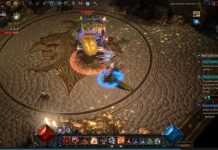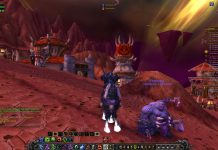In a free-to-play industry that is an ocean of MMORPGs that portray characters running around in a world doing more-or-less fantasy concerned jobs and quests, Star Trek Online is something of an anomaly. As an MMO STO breaks the mold of characters on the ground (perhaps with mounts/vehicles) by giving players an experience that addresses both third-person RPG elements alongside flying capital ships in space.
Ah, the smell of phaser fire in the morning.
Originally developed and published by Cryptic Studios, said studio (and its properties) have been bought by free-to-play publishing juggernaut Perfect World Entertainment. As a result, Star Trek Online has recently gone from pay-to-play to free-to-play and opened up to the world January 17. During this transition much of the player base girded themselves for what they expected to be an onslaught of the unwashed into their game and the rest of the world prepared to enjoy a game based on Star Trek that had been locked away for some time.
Behind the curtain, Star Trek Online does an excellent job of conveying the Star Trek universe and all of its considerable components. As a franchise, movie and literary property, Star Trek is something itself of a cultural phenomenon that is easy enough to capture. It has spawned decades worth of content and a multitude of video games. It also has a great deal of world building and content to draw from to produce a game that will resonate both with fans and newcomers alike.
The MMO manages to do this extremely well by pulling from the multitude of assets provided by the culture and the literary legacy of Star Trek and conveys an enjoyable experience as it does so.
The game is not without some developmental flaws and strange bugs that still persist (none of them too game breaking at first glance) but overall it seems to be a stable and mature game as one would expect from a pay-to-play game that only recently transitioned to free-to-play.
If you’re interested in some video of gameplay and how striking the game is scroll down to near the conclusion and see the MMO Anthropology video there; otherwise, you’re in for a wild read, this game has a lot of quality crammed into galaxy.
Sound and Graphics: Star Trek come to life in an MMO form—nostalgia coma coming up
Normally in a review I start with graphics and make a just-so commentary on sound (unless it’s excellent or terrible) but this time let’s just skip directly to sound. Star Trek is all about sound, everything in the Star Trek universe has a sound—computers beep, phasers pew, ships swoosh, and the Borg scare the hell out of me… The entire Star Trek property is an atmospheric experience that involves a very specific set of futuristic sounds that exist entirely and only to produce the effect that is Star Trekness.
This is something that Star Trek Online does well in spades and shovels.
Since the original series, through The Next Generation, and into the other properties the sound of Star Trek has evolved but it always retains a sort of strange postmodern future-expectation about a sleek universe full of technology that surrounds some wacky special-effect and a particular range of sounds. So STO has all of this to draw upon, decades of Foley and sound work that they’ve sampled and deliver back with a masterful presence.
Everything in the game sounds appropriately Star Trek right down to the sound of auxillary systems coming online, weapons firing, and hits coming in. They even have Majel Barrett-Roddenberry (the voice of the Enterprise computer) doing the computer and Leonard Nemoy (Spock!) doing speaking parts during the game narrating elements of the Star Trek universe as you explore space. It’s beautiful from the perspective of a fan of the franchise.
Then there’s the music. Star Trek has always been accompanied by an almost-orchestral style of music that’s emblematic of the series and all the shows and this shines through in the game. The music follows you everywhere you go and it’s all long scores so it doesn’t repeat on a short loop; furthermore, it fits nicely to the scenes playing—there’s battle music, there’s flying through space music, there’s alien world music. My only gripe here is that the amount of music itself is a little minimal for each environment; the game could benefit from having a bit of variety added.
Then we come to the graphics… At this point I’ll mention that there’s some odd little glitches even on my system (which is quite high end) but it’s nothing show stopping. Overall, it looks like a modern game that’s showing a little wear-and-tear of being on the market for a while, but the polygons still pass the looking good test.
There’s a distinct feel to the game that also reflects the Star Trek property here that’s hard to convey. It’s a science fiction game with a lot of elements that take from all over the Western cultural scifi heritage. Alien planets have strange (often ugly) plants, ugly buildings, and obviously Star Trek architecture. And space scenes have nebulae and stars visible in the distance and an overwhelming sense of vastness—although space is oddly cramped and crowded these days.
The spacecraft are quite nice, models of ships from across the Star Trek movies, books, and other places with designs that run from the sleek and exciting to the somewhat blocky and hideous. There’s a multitude of elements that can be switched in and out for them and they retain very ST-like silhouettes that anyone who has seen one of the shows or movies will recognize at first glance.
Weapons fire has a considerable amount of special-FX applied to it and the battles are like space fireworks.
The UI floats a little bit weirdly and sometimes feels a little bit cramped on the screen; but it gets the job done. It also has the glowing faces and the rounded corners of the recognizable LCARS system design from Star Trek: The Next Generation.
This really is a game developed to cater to fans or at least people with a passing familiarity with the franchise—although it’s still more than accessible enough to people who haven’t had any experience with Star Trek at all.
Gameplay: Functioning capital ship combat, “Away Teams” … and tribbles?
Here’s where Star Trek Online starts to stand out a little. There’s two distinct modes of gameplay: ground and space. The game switches between them fairly well by having ships flying through space and shooting at one another and then Away Team missions that bring the player into a ground-based scenario. This is actually pretty fun and reflects the Star Trek universe and the shows extremely well.
Space-based missions involve capital-ship combat where the player needs to understand the way that Federation and Klingon ships operate. There’s some very complex interactions involved—but most people might be able to get away with just hammering the alpha-strike “fire all weapons” button in most fights. However, for those who want to pull the most DPS or support out of their ships can come to understand power systems and weapons.
Ship fighting involves a bit of strategy. Since it’s space, ships move around and must turn, weapons and shields also have “fields of fire” and “field arcs.” Choosing weapons is more than just picking what fires fastest, causes the most damage, or the best debuffs; but also how it might work on the particular ship or with a particular play style. All the classic Star Trek weapons are involved: phasers, disruptors, poleron weapons, tachyon weapons—oh, and of course photon torpedos (and all their variants.)
Flying a ship through space, zapping a target with phasers, and pounding it with torpedoes can be a great deal of fun. All the different types of ship and officers offer a lot of interesting abilities that change combat.
The player chooses an officer career path between Tactical, Science, and Engineering. Tactical officers receive a lot of benefits to space and ground combat—and abilities that reflect this such as being able to fire torpedos/energy-weapons with increased damage; Science officers receive abilities that affect and debuff enemies; and Engineering officers get abilities that buff and defend the ship with better shields and faster repairs of damage.
On the ground, the character gets an Away Team. This team is made up of officers from the bridge crew—the favorite odd conceit of the Star Trek universe where committing the highest ranked officers to the most dangerous missions is a norm of the drama. The only time a player is alone in a mission is if there’s need for that—otherwise there’s at least 5 NPCs with you shooting, throwing bombs, etc.
Ground combat is a little bit weird and gimmicky, however, and while it allows players to enter into a hybrid-FPS mode, most of the time you’ll probably be hiding behind Away Team members or dodging slow moving Borg. Also, some of the ground quests suffer a really annoying tendency to ask for 10 or 50 of an item (an old MMO trope that’s somewhat tiring.)
Star Trek Online is highly soloable.
In fact a great deal of the episodic content is designed around giving players the ability to play through the story and interact with the game world without having to team up. There’s a gigantic amount of content in the episodic content to play through and some people go through the entire game without grouping up.
Of course, this doesn’t mean that there isn’t content designed for groups such as Task Forces (think raids) and daily events that involve fighting off incursions by the Borg, the Mirror Universe, Species 8472, and others. The entire cast of decades worth of Star Trek foes exists in the game as a pixelated punching bag and loot piñata for the enterprising player.
Freemium: Dilithium and Cryptic Points make a strange but functional economy
As a game recently changed from pay-to-play to free-to-play Star Trek Online has a vast universe with a great deal of free content to offer; but it also needs to discover how to pay the bills now that subscripions have been nixed. Of course, subscriptions still exist in the type of Gold membership (free is called Silver) which runs at about $15/mo.
Like many free-to-play games with ancillary subscriptions Gold players receive some benefits in greater inventory space, access to founding guilds (fleets in STO), voice chat without adds, an extra character, extra ship slots, etc. Many of these amenities can also be bought by free-to-play players. Gold members don’t receive anything that really differentiates their gameplay that much from Silver members or makes them superior in PVE or PVP. They just have a little bit easier access and more stuff in the game world.
Since this is a Perfect World Entertainment game the microtransaction currency Cryptic Points (named after Cryptic Studios) is bought with ZEN. It’s about 100 ZEN for 80 CP—which makes $1 per 80 CP. Some examples of in game prices is that certain Lieutenant Commander level ships cost 440 CP and that runs around $5.5. Of course, these are just different-looking ships moreso than anything special. Renaming a character is 280 CP ($3.5).
Borg bridge officer? 400 CP ($5). The most expensive ship costume in the game is the Cruiser Dreadnaught (basically it looks like a Galaxy-class with 3 nacelles and it’s huge) and that will set you back 2,000 CP ($25).
The in-game commodity currency is dilithium which is earned from playing the game, running missions, and can buy specialized equipment. Dilithium can be refined from dilitium ore at 8.5k a day. Dilithium can also be exchanged for Cryptic Points—the exchange rate changes throughout the day and is regulated by the “Dlithium Exchange” much like is done in Spiral Knights. This means that free-to-play players who don’t want to purchase CP can still get it by trading in their refined dilithium. Vice-versa, players who purchase CP can get a boatloads of dilithium by exchanging their CP for dilithium (to buy commodity and rare equipment.)
Conclusion: Play this game or the Borg will assimilate you
Are you a Star Trek fan? If so, you’ll probably adore this game even with its glitches and strange gimmicks.
The diversity of gameplay modes, quests, things to do, and a huge player base all work in favor of this game. As a free-to-play player, you’re not as limited as in other games; but there’s a great deal to explore from and enjoy within the virtual item shop if you have the cash. Also, casual players with some extra money will find themselves easily keeping up with their hardcore friends in dilithium with just a few bucks at a time.
The nostalgia is strong in this game but it also provides a workable framework within which to play an MMO game. There’s hundreds of hours of content to play through all of which contain their own television episodic storytelling and narrative. It’s possible to solo the entire game and run missions daily and weekly; and it’s also possible to come in for friends and an enjoyable social experience.
The game is beautiful and although it’s starting to wear at the edges graphically for the most part it looks the part of a well-built MMO game. Being that it’s coming out of pay-to-play to free-to-play also means that most of the production value has already been sunk into the game (although some might be questioning where that might go with F2P…)
The best part, as free-to-play you can be as casual or as hardcore as you like. There’s no pressure to make sure you play if you’re not subscribed and you can come and go from the universe as you please.
So pull up a captain’s chair, divert power to the engines, and warp into Star Trek Online.



















